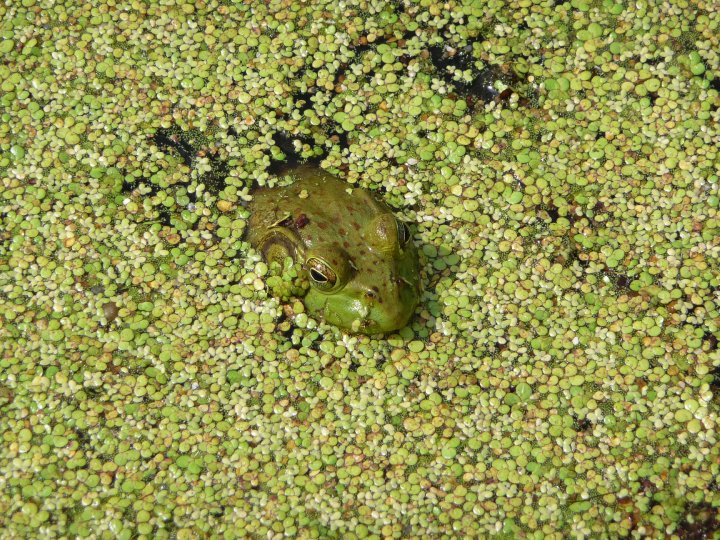
By Soni Cochran, Extension Associate, Lancaster County
Statewide, there are 11 different types of frogs and toads in Nebraska. All of them are native species, except one: the American bullfrog (Lithobates catebeianus). American bullfrogs are an invasive species and they are causing problems. These invasive frogs are no different than other invasive species (think Japanese beetles or zebra mussels). It is important to decrease their numbers, while increasing the number of frogs and toads native to Nebraska. The American bullfrog is currently the only frog species listed as invasive in Nebraska.
ABOUT BULLFROGS
The bullfrog was originally brought to far southeastern Nebraska in the 1800s by French fur traders as food stock. They became established statewide and throughout the western United States as a result of fish stocking and farms that raise frogs.
American bullfrogs are found in reservoirs, ponds of all sizes, cattle tanks, bogs, and areas where rivers and streams are sluggish. Although bullfrogs are the largest frogs in Nebraska (7–8 inches long), they have the smallest home range. If you have a pond, they will stay near it most of the time.
The frogs breed late April to June. One female bullfrog can produce up to 20,000 eggs. The eggs float on the surface of the water in a cluster. Tadpoles are large and can be over 6-inches long. It is not uncommon for young bullfrogs to move to nearby ponds in order to escape cannibalistic adults. These frogs hibernate in winter by burying itself in the mud and emerging in spring.
Bullfrogs will eat anything they can put in their mouths. This includes birds, fish, crustaceans, bats, snakes, turtles, small mammals and other frogs. In areas where bullfrogs have been introduced, the frogs are blamed on the decline of native frogs, snakes and amphibians. Bullfrogs will also eat other bullfrogs. Bullfrogs have their own predators including birds like herons, egrets and belted kingfishers. Raccoons, mink, otter (yes, we have otters in Nebraska), snakes and large fish will eat bullfrogs. Crawdads will eat bullfrog eggs and sometimes tadpoles. People also enjoy eating bullfrogs.
BULLFROGS AS FOOD
To help keep down their populations, consider trying American bullfrogs as a food source. American bullfrogs are a game species in Nebraska and many people enjoy hunting them. The season for hunting bullfrogs runs from August 15 through October 31. You still have time to get out and try your hand at hunting bullfrogs. Bullfrog hunters must have a current, valid Nebraska fishing license in order to take or attempt to take them.
There are limits on the length for any bullfrog that is captured. There are also limits to how many legal-sized bullfrogs you can have in your possession. Capture of bullfrogs must be by hand, hand net, or hook and line. Gigging (using a multi-pronged spear), spearing or shooting with a firearm or bow is not allowed. If you hunt frogs, Nebraska law allows for the frogs to be transported alive or gutted, but the entire body of the frog must be left intact during transport. For more information on regulations to harvest American bullfrogs in Nebraska, contact Nebraska Game and Parks, 402-471-0641 or visit http://outdoornebraska.gov.
Although you can eat many parts of a bullfrog, most of the meat is on the legs and loins. Do frog legs taste like chicken? Some people describe the meat as a cross between chicken and fish. Others say the legs taste like chicken with a texture similar to chicken wings. I had bullfrog legs this summer and they tasted more like fish than chicken to me. The meat was very lean and you have to be very careful not to overcook it.
OTHER WAYS TO REDUCE BULLFROG POPULATIONS
If you don’t want to eat bullfrogs and you have a backyard pond, reduce the number of fish in your pond or remove all fish. Fish do not like to eat bullfrog eggs or the tadpoles because they are distasteful. Fish will eat plenty of our native frog and toad tadpoles. Without fish in the pond, native frogs and toads have a better chance of making it to adulthood. You can also remove bullfrog egg clusters and adult frogs, but make sure you know how to identify bullfrogs since native frogs may look similar.
Sources:
• http://wildlife.unl.edu
• Nebraska Game and Parks Commission
FOR MORE INFORMATION
University of Nebraska–Lincoln’s identification guide to snakes, turtles, frogs, lizards and salamanders is online at https://herpneb.unl.edu.